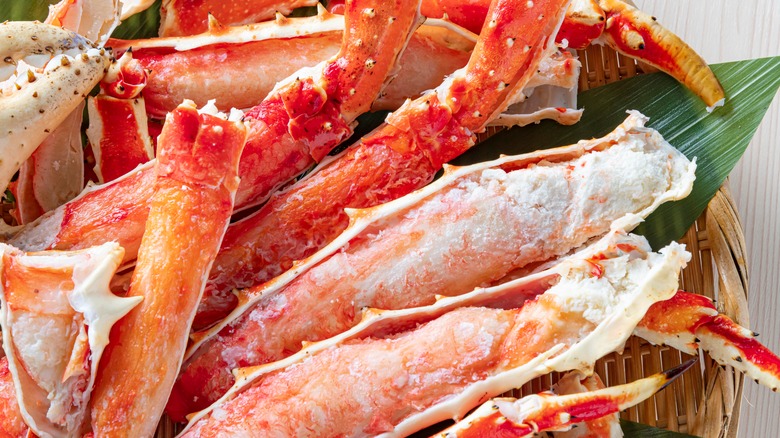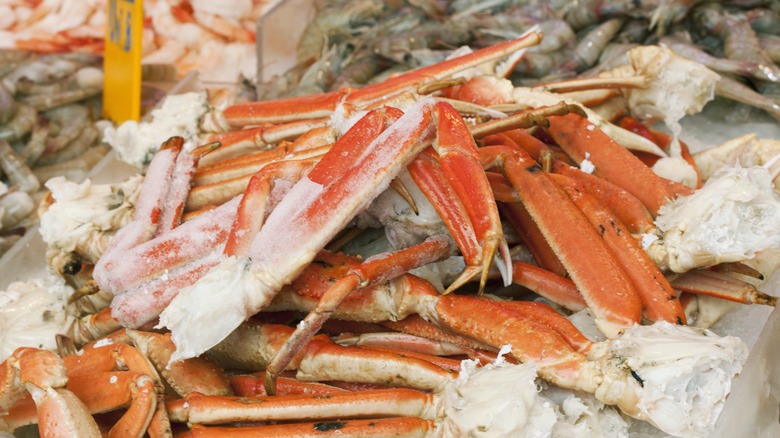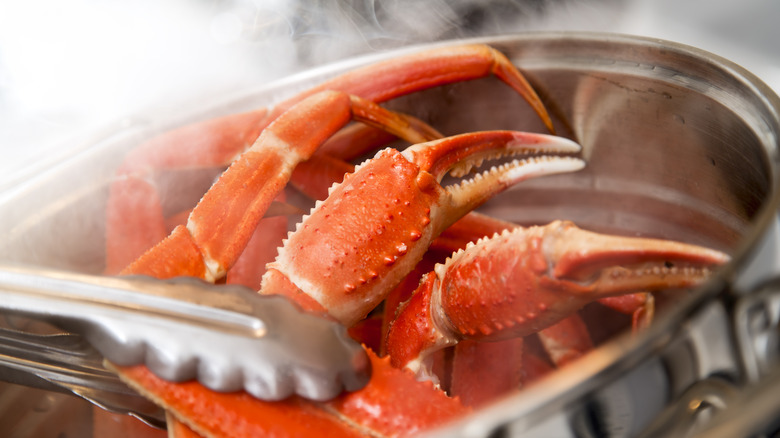The Red Flag To Avoid When Shopping For Crab
Like all seafood, crab requires attention to detail when distinguishing the good from the bad. Shopping for this crustacean can be intimidating, especially since you don't want to spent big bucks on subpar crab, but if you know what to look for, you can steer clear of inferior products. And one of the biggest red flags is a strong, fishy odor.
Whether you're buying snow crab, king crab, or any other kind, fresh crab should smell clean and a bit sweet, with almost no other odors. Any sort of fishy or musty smell is a sign that it's begun to spoil. This is true for many other kinds of seafood, too — fresh fish shouldn't smell fishy, either. Likewise, you should avoid crab meat that has any kind of discoloration, especially tinges of blue and gray, as this signals that the meat hasn't been stored properly. Instead, crab meat should be mostly white, with some red hues.
You should also avoid packages of crab that have ice crystals inside. Freezer burn can signal the meat has been thawed and refrozen, and it could have spent time in the temperature "danger zone" where bacteria can grow. This range is between 40 degrees and 140 degrees Fahrenheit, per the USDA. Temperature fluctuations can also affect the meat's texture and taste, dramatically decreasing its overall quality. If possible, opt for live crab and choose ones with hard shells and movement in the legs.
Eating bad crab can have serious consequences
Aside from having an unpleasantly mushy texture and rank smell, spoiled crab meat can pose a serious danger to your health –- namely in causing various kinds of food poisoning. Sometimes, crab can make you sick even if it's not spoiled, as it may be contaminated with environmental bacteria. One of the most common threats is toxins, like the paralytic shellfish toxin, which typically come from algae in the crab's environment. Though crabs themselves do not directly ingest the algae, their prey does, leading to a buildup of toxins in the crabs' digestive tracts.
According to the CDC, symptoms of shellfish poisoning can include numbness, tingling, headache, confusion, nausea, vomiting, and diarrhea. Effects can set in quickly, sometimes in a matter of minutes. As victims may need help breathing, you should seek medical assistance immediately if you begin showing symptoms.
To avoid illness when preparing whole crabs, always remove the crab's viscera and safely dispose of it. Cooking or freezing will not kill the toxins in the crab's guts, nor do affected crabs show any visible signs of being infected. You should also take note of where the crab came from, avoiding regions known to be susceptible to algae contamination. For instance, if you're in an area that has experienced an algae bloom (called "red tide" or "brown tide"), don't eat locally-caught crabs. No matter how tasty the crab, it's not worth the potential illness.
Reduce risk of illness with proper cleaning and preparation
Algae and spoilage aside, crab can also become a deadly dinner if not prepared correctly. As mentioned earlier, repeatedly freezing and re-freezing crab can cause the meat to dip into temperature ranges where bacterial growth is accelerated. Likewise, undercooking (or forgoing cooking altogether) can leave bacteria intact on the crab, so the meat should always be cooked to at least 140 degrees Fahrenheit.
In addition to being ingestible, foodborne bacteria like vibrio can also infect people through open wounds, per NYC Health. As such, you should always wear gloves when handling raw seafood, and be sure to thoroughly disinfect any utensils and work surfaces that come into contact with the meat.
When storing crab in the fridge, keep the raw meat juices at bay by storing the crab with paper towels underneath to soak up and hold excess moisture. Always keep raw meat on the bottom-most shelf of the fridge, so that if a leak occurs, contamination is far more limited than if the juice were allowed to leak from the top shelf. Finally, give the shelf a good disinfecting once all the meat is gone, which will remove any last traces of bacteria.



